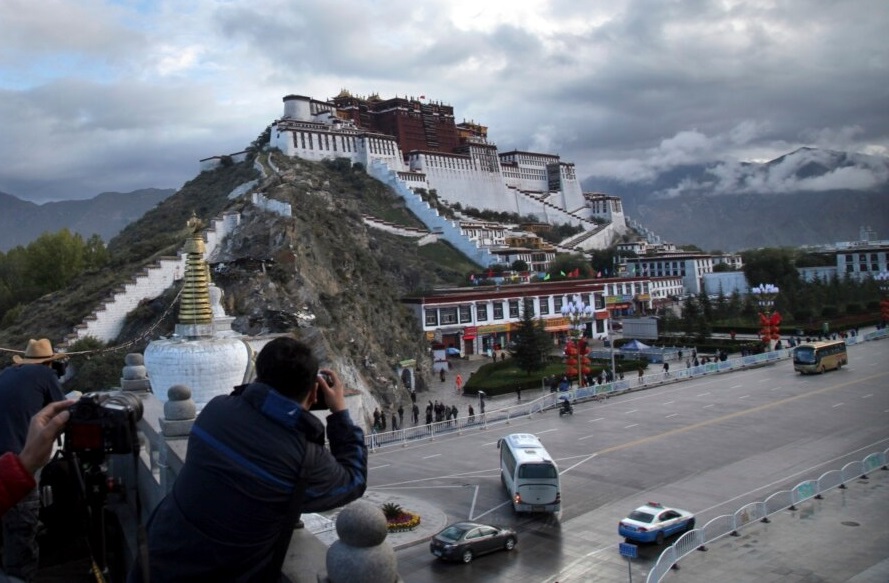Sinicizing Tibet: China’s Efforts to Suppress Tibetan Identity and Religion
Share

China terms the Dalai Lama as a “splittist” and “separatist” and yet are so scared of him and his influence over Tibet and the Tibetan people that they impose strict measures to ensure that his birthday is not celebrated. This is precisely what happened this year too, as the Chinese government put in place stringent social media restrictions to keep Tibetans from celebrating the 6 July birthday of the Dalai Lama. The Chinese have gone a step further in the ‘Sinicization’ of Tibet by frequent visits by prominent members of the Communist Party of China (CPC) to Tibet with the message that they should be loyal to the party and promote themselves as ‘Chinese’ and not ‘Tibetan’.
In the run up to the Dalai Lama’s birthday this year, Chinese authorities have more rigorously checked the cell phones of Tibetans to ensure they have not downloaded any photos of the Tibetan spiritual leader. There is already a ban on the possession of photos of the Dalai Lama, as well as posting of his images on social media. The Dalai Lama’s knee replacement operation in the US has made Chinese authorities more alert as Tibetans have taken to social media to express concerns about his health and may be sharing his photos on social media. This has led China to warn Tibetans not to contact their family members living overseas.
Reuters reports that local governments in have prohibited people living in the Tibet Autonomous Region and in some Western provinces having Tibetan-populations from communicating with the outside world about the Dalai Lama’s birthday. It is in this context that one should view the recent visit of CPC and other senior officials to Xining in Qinghai, Kardze (Ganzi) TAR, and Ngaba (Aba) Tibetan & Qiang Autonomous Prefecture in Sichuan. Primary amongst them was President Xi Jinping who asked Tibetans to regard themselves as ‘Chinese’ and demanded loyalty to the CPC, and instructed Tibetans to integrate their religious practices with the CPC’s value system. Xi visited a middle school for Golok Tibetans and the Tibetan Buddhist Hongjue Temple in the northwestern province of Qinghai, in the provincial capital Xining. The historic Hongjue temple has been key to China’s communication with Tibetan Buddhist leaders since 1951.
The June 2024 visit by President Xi and Wang Huning, Chair of the Chinese People’s Political Consultative Conference is connected to anxiety amongst the Chinese leadership concerning the Dalai Lama’s reincarnation. Some clues to this apprehension is found from the reports of a “news tea party” organized by the All-China Journalists Association on Tibet on 27 June 2024. Staff from the Beijing-based China Tibetology Research Center (CTRC) were there to respond to questions. One reporter asked about the attitude of the Chinese government to the possibility of the Dalai Lama announcing his reincarnation plan at the age of 90, something that Tenzin Gyatso had said in his 2011 statement on the subject.
Lhajam Gyal Deputy Director at CTRC responding to the question mentioned the “Regulations on the Management of the Reincarnation of Living Buddhas in Tibetan Buddhism” of 2007 adding that “Although the Dalai Lama is currently outside China, his reincarnation is still part of the [Tibetan Buddhist] Gelug tradition and under the jurisdiction of the Chinese government, as most temples are located within China.”
Since 2011, Chinese authorities have been making efforts to control Tibetan Buddhists in Tibet, repeating CPC standardized narratives on reincarnation, and strengthening their administrative measures. When Xi and Wang came visiting this time around discussions with provincial leaders focused on measures to control Tibetan Buddhists. Additionally, China continues efforts to indoctrinate the Tibetan Buddhist community, particularly the reincarnate lamas. They took a group of young Tibetan Buddhists in May 2024 to a study tour of different Chinese cities including Beijing. This was followed by the publication (in July), of a series of essays in the state media by some of the lamas who were taken on the indoctrination tours.
Most of these so-called “personal reflections,” these essays, are in fact written by Chinese officials, but published under the names of young reincarnate lamas. For instance, 18-year-old reincarnate lama Dorjee Lodroe from Lhorong (Luolong) county in Chamdo (Changdu) city concludes his piece by writing: “In my future studies and practice, I will cherish the hard-won learning opportunities, implement General Secretary Xi Jinping’s earnest teachings, and move forward firmly on the path of becoming an outstanding monk in the new era. I will always listen to the Party, be grateful to the Party, and follow the Party, and strive to become a qualified monk in the new era!” There could not be a clearer statement of Chinese political jargon that this!
During his visit to Xining in Qinghai, Xi visited a boarding school funded and built with assistance from Shanghai for students from the pastoral areas in Golog (Guolo) TAR. The attention given to a boarding school for Tibetans is to show that all is well in these schools as there remains international concern at CPC policy about the mass assimilation of children of Tibetan nomads and herders in the Chinese boarding school system, away from their Tibetan parents and their culture. The glaring omission in this propaganda narrative is the absence of any mention of the students being able to learn about Tibetan history or the Tibetan language.
Since assuming CPC leadership in 2012, President Xi has made three visits to Qinghai, in 2016, 2021 and most recently in June 2024. Interestingly, state media it did mention that UFWD Minister Shi Taifeng accompanied Wang Huning to the Tibetan areas in Sichuan. Thus, in the minds of the CPC Tibet remains to be fully assimilated into China. This is both through the brainwashing education system of the boarding schools and by ensuring that Tibetans do not show their respect for their spiritual leader the Dalai Lama.







